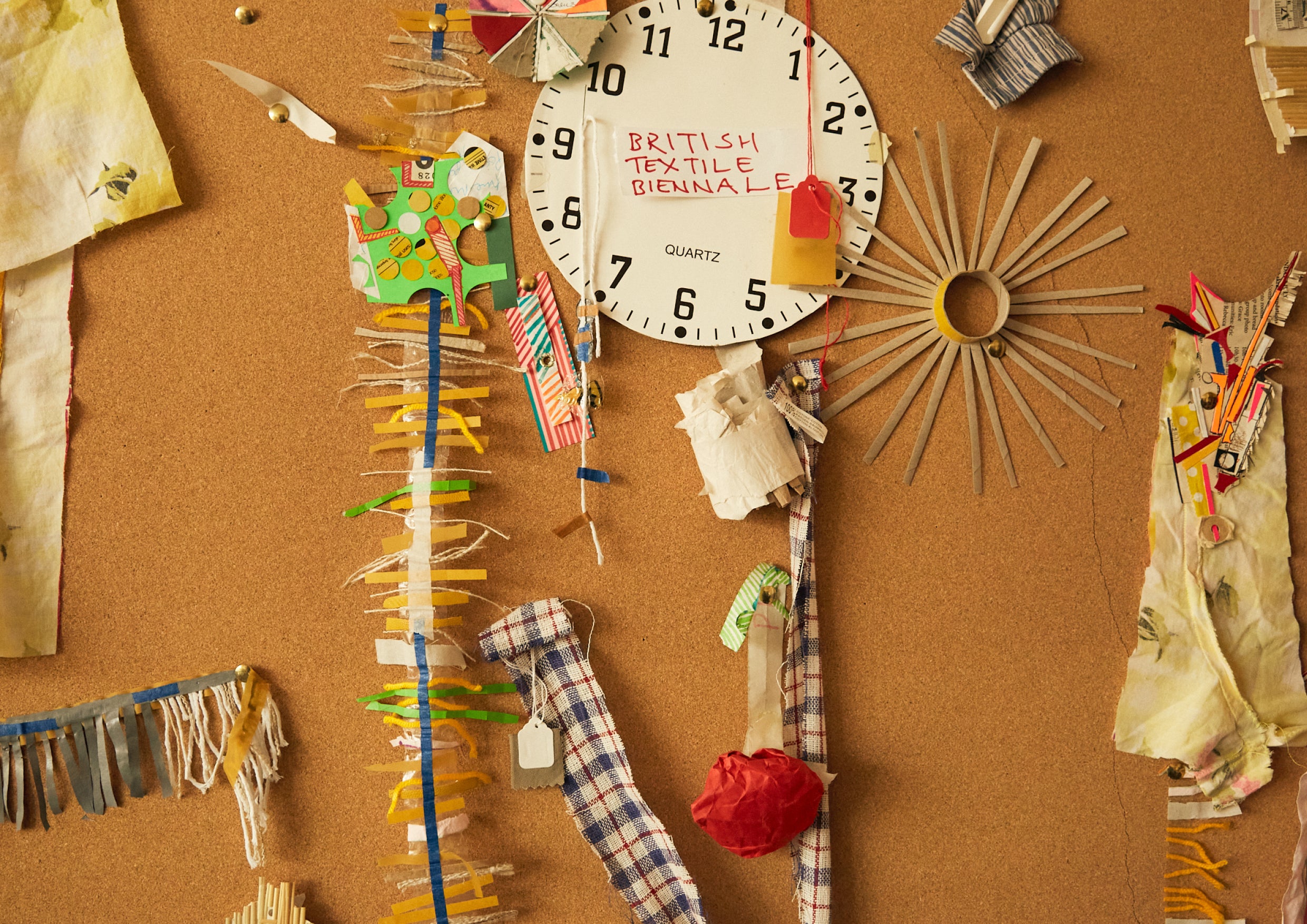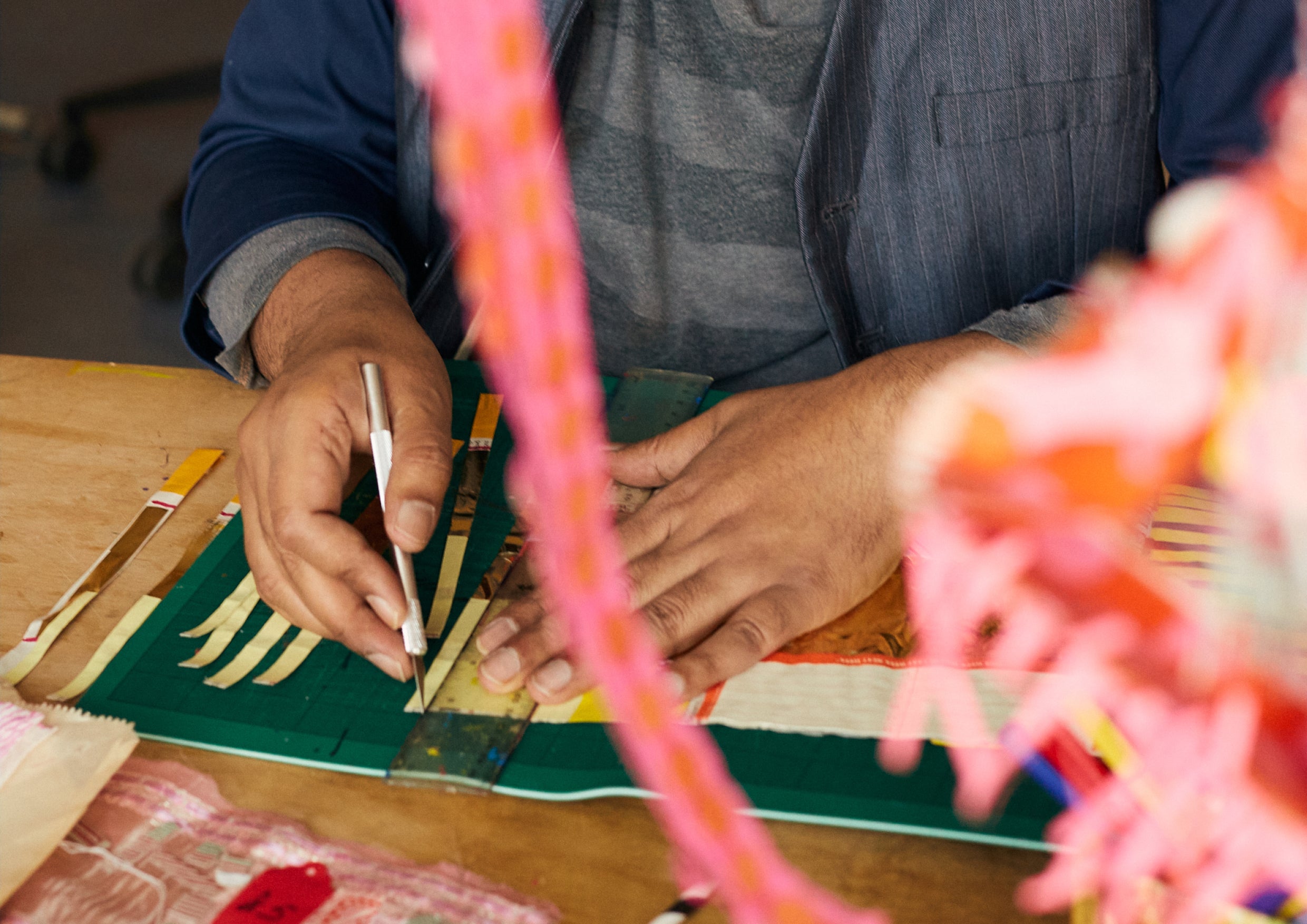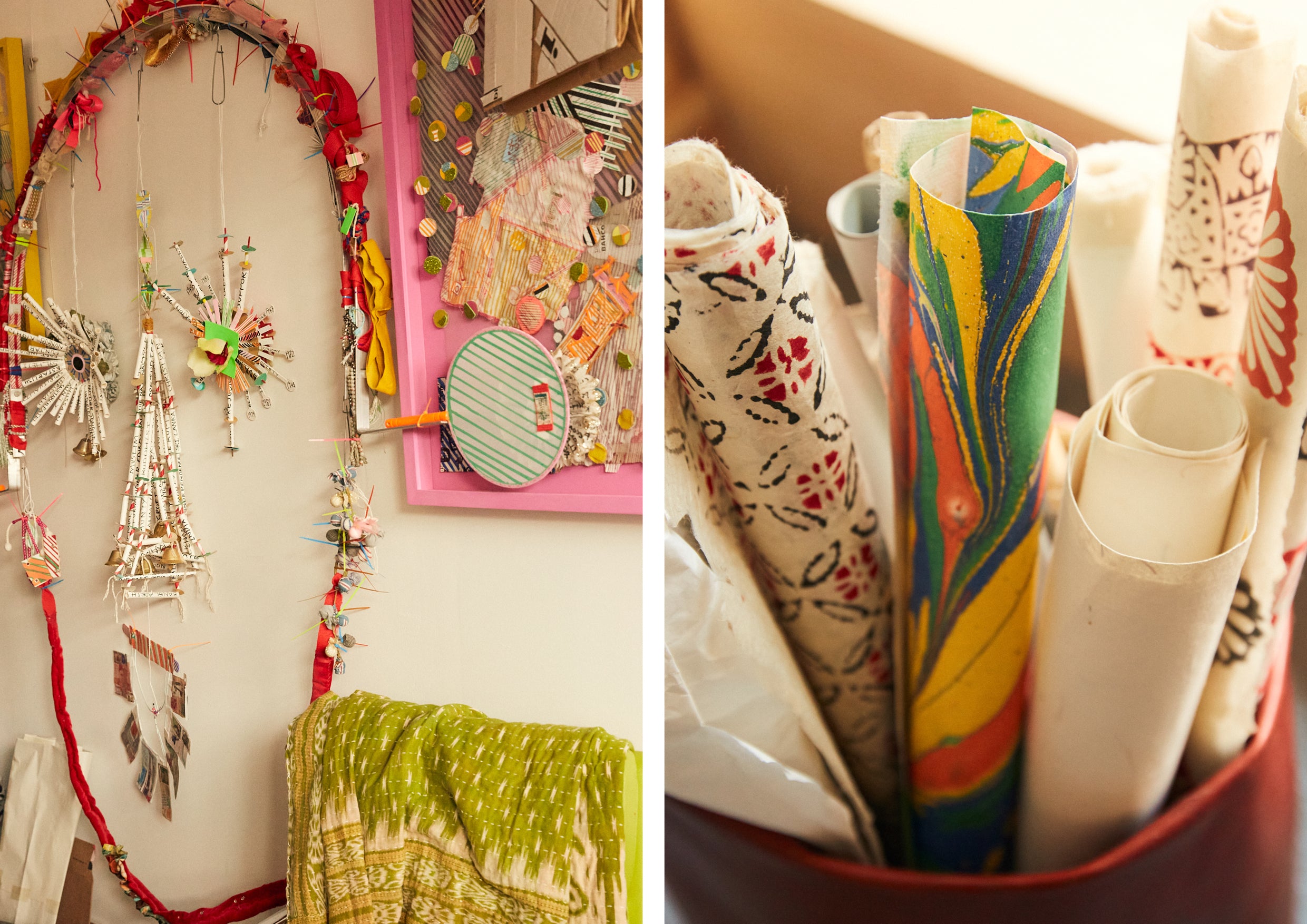 Liaqat Rasul’s studio is a wonderland. Strips of vibrant and printed fabrics hang in bundles from hooks on the walls. Cork boards are covered in found materials, from train tickets to bottle tops. Large abstract mobiles of faces swing from the ceiling, with eyes, lips and noses suspended from the outline of the heads. A cacophony of colour and texture, the collage and fibre artist’s studio in Bromley-by-Bow houses the countless ephemera he collects for his practice, his process unfurled in every corner of the room. “It’s sporadic, messy - I’m a bit of a hoarder,” he says. Through stitching, stacking and stapling these contrasting elements together, Liaqat’s cartographic practice finds innovative ways of reworking found materials to cast them in a new and hopeful light.
Liaqat Rasul’s studio is a wonderland. Strips of vibrant and printed fabrics hang in bundles from hooks on the walls. Cork boards are covered in found materials, from train tickets to bottle tops. Large abstract mobiles of faces swing from the ceiling, with eyes, lips and noses suspended from the outline of the heads. A cacophony of colour and texture, the collage and fibre artist’s studio in Bromley-by-Bow houses the countless ephemera he collects for his practice, his process unfurled in every corner of the room. “It’s sporadic, messy - I’m a bit of a hoarder,” he says. Through stitching, stacking and stapling these contrasting elements together, Liaqat’s cartographic practice finds innovative ways of reworking found materials to cast them in a new and hopeful light.
Studying fashion at the University of Derby, Liaqat spent a year in Delhi working with local designers. He returned to the UK with reams of embroidered fabrics that he’d commissioned to create his graduation collection, which Liberty went on to buy. “It was bonkers,” he admits. He set up his womenswear brand, Ghulam Sakina - meaning beauty and servitude in Urdu - and moved to Delhi, enjoying a decade of global success with partners like Selfridges and Browns, as well as across Japan and the Middle East. Then, in the financial crash of 2008, his business liquidated.

 “It came out of nowhere,” he reflects. “I just worked in a pub for five years and had to go through it.” A new demand for experience in creating designs with computer software led to fruitless and frustrating meetings with fashion brands. “I was quite unemployable because I’d never worked for anyone else before and it seemed as though people didn’t value that hands-on approach that I was used to,” he says. “It made me feel useless. It was a weird time.”
“It came out of nowhere,” he reflects. “I just worked in a pub for five years and had to go through it.” A new demand for experience in creating designs with computer software led to fruitless and frustrating meetings with fashion brands. “I was quite unemployable because I’d never worked for anyone else before and it seemed as though people didn’t value that hands-on approach that I was used to,” he says. “It made me feel useless. It was a weird time.”
Seeking inspiration outside of work helped Liaqat find his flow again. “I just went to loads of art exhibitions, that was my only saviour.” He began creating collages for friends and family, “birthday cards, mostly, but there was a nice energy about them because nobody was critiquing them. It was great to create things off-piste and not on a schedule,” he says. “No restrictions, just joy. I thought, maybe I can do something here.”
 The low-tech, free-flowing creativity at the start of Liaqat’s craft mirrors his process-driven output today. His use of vibrant colour is directly inspired by his time in Delhi, as is his resourcefulness. “In India they’re really creative with things like toy making,” he says. “People use whatever materials they can find to make objects that have real energy and character. They don’t shy away from colour or texture or intensity, and that’s been a beautiful influence on me.”
The low-tech, free-flowing creativity at the start of Liaqat’s craft mirrors his process-driven output today. His use of vibrant colour is directly inspired by his time in Delhi, as is his resourcefulness. “In India they’re really creative with things like toy making,” he says. “People use whatever materials they can find to make objects that have real energy and character. They don’t shy away from colour or texture or intensity, and that’s been a beautiful influence on me.”
Though Liaqat’s collages, installations and mobiles don’t begin with a defined concept, messages of time, technology and politics run through the fibre of his pieces. “We used to write letters and receive things in the post - how wonderful an experience that was,” he says. “People don’t write notes anymore, they don’t know what their handwriting looks like. When you type, does your brain engage with what you’re saying as much as when you write? I do romanticising these processes - someone once took care to produce these items.” Amongst the vibrant shades of salvaged tissue paper, recycled cardboard and fuzzy pipe cleaners, Liaqat’s studio is full of boxes of receipts. “Some receipts can be beautiful, like those from the ‘80s with a hand-written invoice or stamp. I find myself asking, why am I collecting these? But they have dates on them, they document periods of time.”
 If the preservation of time is not a conscious theme in Liaqat’s work, then nor is sustainability. “That hasn’t become a part of my work by choice,” he says, “I just quite like the contents of a recycling bag. I like cardboard and different qualities of paper. Sometimes really cheap materials are beautiful, and they get even more exciting once placed next to opposite textures - gloss next to matte or paper against an old plastic bag.” He holds up a velvet gift bag he was given. “It was awful, like the textured wallpaper you find in Indian restaurants, but I’ve cut lots of circles out of it and now it has depth,” he says.
If the preservation of time is not a conscious theme in Liaqat’s work, then nor is sustainability. “That hasn’t become a part of my work by choice,” he says, “I just quite like the contents of a recycling bag. I like cardboard and different qualities of paper. Sometimes really cheap materials are beautiful, and they get even more exciting once placed next to opposite textures - gloss next to matte or paper against an old plastic bag.” He holds up a velvet gift bag he was given. “It was awful, like the textured wallpaper you find in Indian restaurants, but I’ve cut lots of circles out of it and now it has depth,” he says.
Liaqat’s thoughtful consideration of materials reaches further than the aesthetics of his art. The engagement work he does with Hospital Rooms, an arts and mental health charity that brings workshops to inpatient units, relies on non-triggering and overstimulating practices that are accessible to all. “To create within a restrictive framework is amazing,” he says. “You have to rethink everything. Tearing paper, for example, because you can’t use scissors, suddenly becomes a beautiful act. I start every session with ten minutes of meditation, and we close our eyes and hold or scrunch objects with varying textures. Just feeling is enough, and hopefully the brain can take a backseat. To be reminded that we have senses is a good thing.”
 Reimagining the definition of art is key to Liaqat’s perspective. “There are so many ways to engage with community through art, but we’re so focused on prizes and conclusions that often we forget about the process itself.” He is drawn to artists like Thomas J. Price, whose bronze sculptures of contemporary figures challenge preconceived notions of identity, and Alighiero Boetti, whose vast Maps series created in collaboration with Afghani artisans highlighted the skilled craftsmanship of the country during a time of political upheaval. “I like any art that centres community, really,” he says. “We grew up with Constables and Turners, but we all go on our version of an art journey. Anything and everything is possible. It’s difficult to process when we live in a world led by consumerism and profit, but you can be creative with very little - I’m very happy with just a stapler, felt tips and scraps of paper.”
Reimagining the definition of art is key to Liaqat’s perspective. “There are so many ways to engage with community through art, but we’re so focused on prizes and conclusions that often we forget about the process itself.” He is drawn to artists like Thomas J. Price, whose bronze sculptures of contemporary figures challenge preconceived notions of identity, and Alighiero Boetti, whose vast Maps series created in collaboration with Afghani artisans highlighted the skilled craftsmanship of the country during a time of political upheaval. “I like any art that centres community, really,” he says. “We grew up with Constables and Turners, but we all go on our version of an art journey. Anything and everything is possible. It’s difficult to process when we live in a world led by consumerism and profit, but you can be creative with very little - I’m very happy with just a stapler, felt tips and scraps of paper.”
Collaborating with institutions that are facing issues of exclusion, head on, is key, Liaqat says. “Multicultural spaces are really important, but they’re complex - it’s not all smiles.” Last year he exhibited a piece alongside 16 south Asian artists at The Whitaker Museum in Lancashire as part of the British Textile Biennale. The theme for 2023 was What Does It Cost? and the exhibition, Fragments of Our Time, curated by Uthra Rajgopal, explored our impact on the environment and our relationship with textiles. Liaqat’s piece was a two-and-a-half metre tall mixed media mobile face created in response to the collapse of Rana Plaza, a major event for Bangladesh’s safety standards, garment workers’ rights and the fashion industry more broadly.
 'I love the vibrant effervescence of Liaqat's work,” says Rajopal. “It is a startling, bold, tender, giant mobile face-sculpture, precariously layered with everyday objects such as remnants of yarn and fabrics to Bangladeshi stamps, stethoscopes and plimsolls, that are so familiar to all of us but particularly strike a chord with the south Asian community. At its heart is the concept of fragility and when I look at this work - slowly turning round and round - I am reminded of how complicated and unbalanced our cycle of consumption is.”
'I love the vibrant effervescence of Liaqat's work,” says Rajopal. “It is a startling, bold, tender, giant mobile face-sculpture, precariously layered with everyday objects such as remnants of yarn and fabrics to Bangladeshi stamps, stethoscopes and plimsolls, that are so familiar to all of us but particularly strike a chord with the south Asian community. At its heart is the concept of fragility and when I look at this work - slowly turning round and round - I am reminded of how complicated and unbalanced our cycle of consumption is.”
“The Whitaker Museum has large gallery spaces, but it also has a cabinet of curiosities, and here are a group of artists from India, Pakistan and Bangladesh creating art that deals with colonialism,” Liaqat muses. “The British Textile Biennale is great - it’s coming face to face with issues of diversity and gatekeeping and bringing new energy to areas like Blackburn through art. But then we were told to avoid a pub in the local area because the National Front meet there, so that was a real wake up call.” 
A milestone retrospective of Liaqat’s work will be shown at Tŷ Pawb Art Gallery in Wrexham from July this year, tracing the evolution of his artwork alongside the diverse influences that inspire his pieces. Though Liaqat’s work holds a mirror up to some of the stagnant parts of contemporary society, from racial and gender inequality to pervasive anxiety and a reliance on technology, his practice is ultimately optimistic. “Whether it’s collecting ephemera or running community engagement workshops, you’re constantly planting seeds,” he says. “You’re encouraging people to create off the cuff work, and that just encourages you to do the same. An interaction might spark an idea that only appears a few years down the line. I no longer need to rush things. Whatever this practice is, this energy, it takes time. It’s the act of creating the art that’s the beautiful thing.”
NAU, NAU, DOH, CHAAR opens at Tŷ Pawb Art Gallery in July 2024.
Words by Georgia Murray.
Photography by Lesley Lau.
Liaqat wears the TOAST Duncan Exaggerated Tapered Trousers.
Add a comment
4 comments